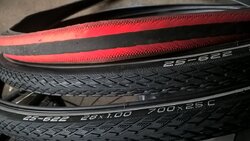Yellow Saddle
Guru
- Location
- Loch side.
You are confusing a bunch of things here.Read what I said again. The issue is the level of hysteresis is different in different tyre designs. This, coupled with the fact that tyres under greater pressure are less prone to deformation per se results in more "bounce" (for want of a better word). The lack of deformation results in upward movement and this reduces downward force and thus friction
Hysteresis relates to internal energy losses inside the tyre and other than the heat that it generates that influences the tyre compound, has no validity in the discussion here.
Tyres under greater pressure are less prone to tyre deformation IN THE CASING. The internal pressure does not affect the tread's deformation. That remains constant.
Downforce does affect overall friction but not the coefficient of friction. But I'm not sure why downforce is even under discussion here. If there was any significant "bounce" as you put it, one would not be able to corner. Bicycles corner very well without the aid of suspension, so bounce is moot.



 that Rubino doesn't look too worn though, be interesting to see how you feel about the new tyres, I propose a test ride
that Rubino doesn't look too worn though, be interesting to see how you feel about the new tyres, I propose a test ride 